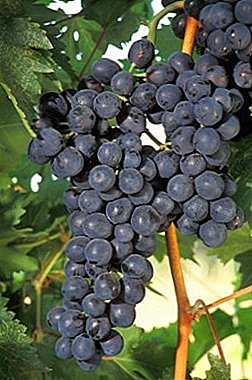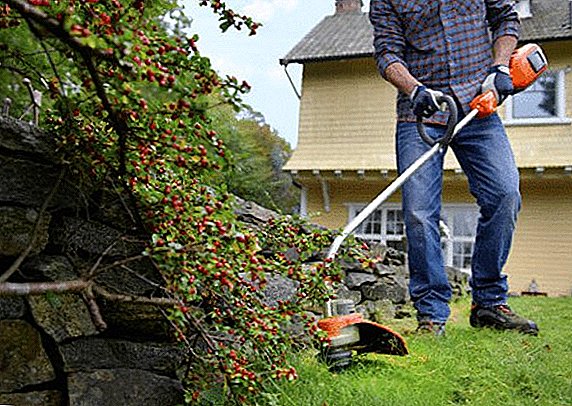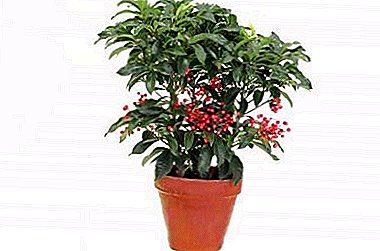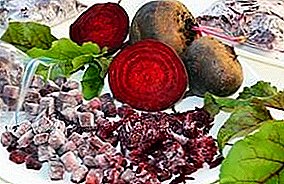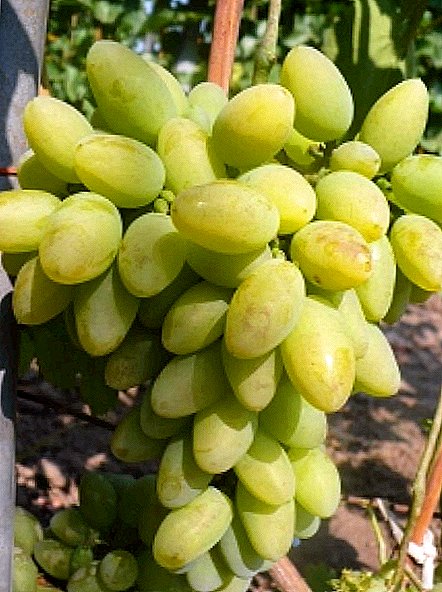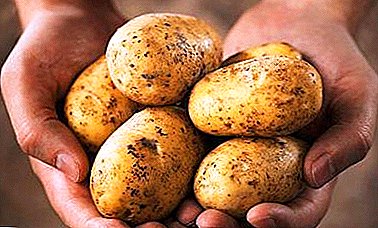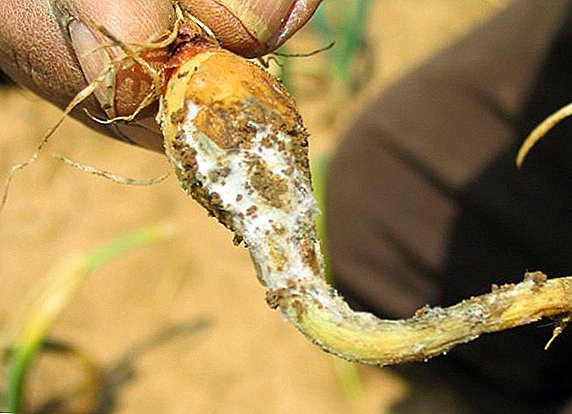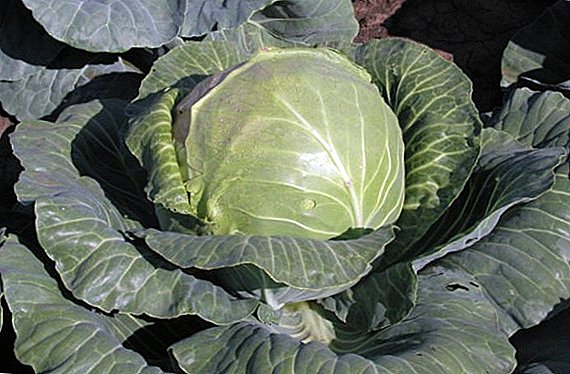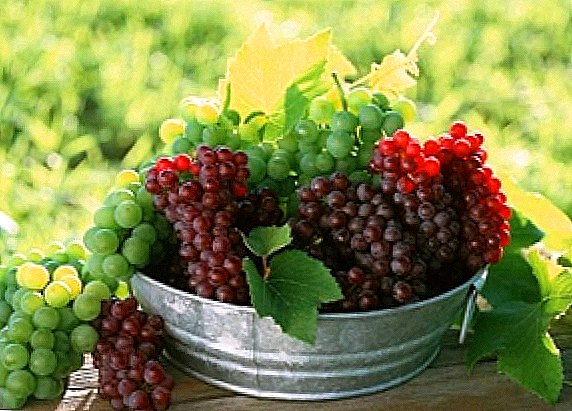
Bunches of table grapes are able to decorate any table with a magnificent appearance of berries and sweetness of pulp.
To make it easier to decide which variety you want to grow in your vineyard, you need to study the main features of several options and choose the one that best suits your taste and climate of the region.
Grade of grapes "White Delight"

The bunches of grapes of this variety are quite large and have a conical shape. Maximum weight clusters sometimes reaches 2kg. Berries are fleshy, oblong, slightly oval in shape. The flesh is crispy, juicy and sweet, protected by a dense soft skin. The color of the berries is delicate, greenish with a golden hue.
According to its yield, this type of grape belongs to medium varieties - from one hectare, with good care, it is possible to collect about 140 centners. The total fruitful shoots about 75%, the number of clusters to escape about 1.6.
"Delight white" refers to one of the very early varieties. Its ripening period does not exceed 120 days.
His undoubted advantages are:
- quite strong growth;
- very tasty and tender pulp of berries;
- good aging;
- large golden-green berries;
- high fruitfulness of shoots (it reaches 85%);
- excellent immunity to pests and diseases;
- the vine is not damaged even at -26 ° C frost;
- ripe clusters have a long shelf life on the vine (up to 1.5 months), while the taste and external characteristics of the berries do not change;
- good transportability;
- big weight of bunches (about 550g).
By cons can highlight the following:
- satisfactory rooting of cuttings of grapes, so it is better to grow it in the form of grafted vine on vigorous rootstocks;
- poor resistance to phylloxera.
Since White Delight is a super early variety, its planting is preferable in the northern regions because, for the safe maturation of the vine, the total temperature for the season must be at least 2000 ° C (for this definition, it is necessary to sum all the average daily temperatures for a certain segment of the season ).
Experienced winegrowers advise plant a vineyard in autumnSince at this time it is more likely to choose a good planting material, and, moreover, the vine, which has been successfully planted in the autumn, will be actively growing in the spring and will bear fruit before the spring seedlings. After all, during the winter period its root system will get stronger enough and will develop.
It is impossible to accelerate the ripening of grapes by any methods in viticulture, but if you plant bushes near the wall of a building, at night, the wall heated by the sun will give its heat to the grapes, thereby increasing the average daily temperature. Before planting, it is desirable to analyze the soil on the site.
If the earth is rich in clay, it is necessary for the vine make good drainageif there is a large amount of peat in the plot, you need to add sand. The sandy area must be properly fertilized with manure or compost.
To obtain the largest bunches from the bush, it is necessary to create a moderate load with eyes (about 25 eyes on a large vine bush) and a good stock of old wood that protects the trunk. Pruning should be carried out up to 3 eyes because the highest fruitfulness of the vine is observed at the base of the grapes.
This variety is well grown on arched formations and vigorous rootstocks. Depending on the climate of the planting region, the vine should be sprayed 1-2 times with oidium and mildew products.
About grapes "Talisman"

Clusters of the Talisman variety are white-yellow in color, rather large, slightly friable, and conical in shape. Usual weight ripe bunches is 1100g. The berries are fleshy, with a good sugar content, when matured, acquire the aroma of nutmeg.
"Talisman" refers to high-yielding varieties. The number of fruit bearing shoots on a bush is about 85%, and the number of clusters per shoot is about 1.7. Cuttings have excellent rooting.
By the time of ripening - this is a mid-early grape (about 130 days).
TO merits This variety can be attributed to:
- excellent taste of berries (high sugar content of 21% and acidity of 6-8g / l);
- large size of berries;
- characteristic nutmeg aroma of pulp;
- high transportability;
- high yield;
- excellent rooting cuttings;
- strong growth of seedlings;
- early entry into fruiting;
- vigorous seedlings;
- long hanging of the harvest on the bush with preservation of taste and external features;
- excellent resistance to diseases such as mildew and gray mold;
- enhanced frost resistance (up to -25 ° C).
There are no significant deficiencies in this variety. But when it is grown, it is desirable to provide rationing with yield and additional pollination of bushes.
When planting should check the soil for the presence of salt marshes. Grapes are not very supportive of such sites. It is better to choose a well-lit area, ideal for planting will be a gentle slope, facing the south or south-west.
You can not plant bushes of grapes in places where there is stagnation of cold air, and close groundwater. 14 days before planting vines desirable dig a good plot, acid soil mixed with lime in the proportion of about 200g per 1 sq. m. plot.
Time for planting can be chosen both in spring and in autumn. In the south - this is about the 15th of May, and in the north, a little later, at the end of May - if you chose spring. Autumn planting time depends on the proximity of the onset of the first frosts in the region - usually the period from September to November.
The main condition should be a good warming of the earth and an imminent approach of frost.
This grape is especially popular because it has excellent resistance to various diseases and pests, as well as frost. It is not required to cover in the winter. Since there are 2-3 inflorescences on the shoots, it is impossible to forget about rationing yield. Also should provide additional pollination during the entry into flowering bushes. By ensuring timely watering and additional feeding, a record level of harvest can be collected from this grape variety.
It is also interesting to read about pink grapes
Sweet variety "Arcadia"

Variety "Arcadia" - is one of some varieties that are derived from the crossing of "Cardinal" and "Moldova." As a result, he received all of their best qualities - amazing sweetness, resistance to various damages and high quality.
The bushes are quite tall, but sometimes they are also found in the middle - it depends on the care technique and the quality of the seedling itself. With good care conditions, the size of clusters can reach 2 kg.
The berries are white, rather large, egg-shaped, or heart-shaped. Sugar content reaches 16%, which is not very much, so the taste of "Arcadia" is very light, tender and not cloying. With full ripeness pulp gets the flavor of muscat and has good juiciness. The skin is quite strong, not thick, well protects the berry.
By the number of harvested crops, “Arcadia” can be considered a leader among other grape varieties. On one bush of fruitful shoots about 75%, and the coefficient of fruitfulness is 1.5.
"Arcadia" - an early variety (ripening time is only about 120 days).
Benefits Varieties "Arcadia" are:
- excellent transportability;
- high yield;
- good root system of saplings;
- the rapid growth of the bushes;
- early fruiting;
- high taste and appearance;
- excellent immunity to mildew;
- good resistance to winter cold (up to -21 ° C);
- excellent compatibility with a large number of stocks.
The only disadvantage in caring for these grapes is that it is necessary to rationalize the inflorescences, otherwise, as a result, you can get a large number of unripe clusters on the bush, which can cause the vine to die as it tries to pull out the entire crop.
"Arcadia" is sensitive to the level of care for her, so you need to make an effort to achieve good results.
Saplings have a fairly good root system, which undoubtedly simplifies the planting procedure. Excellent rooted on all types of soil. But not too "celebrate" the salt marshes. If groundwater is located close to the plot chosen for planting, then the bottom of the landing pit should be build good drainage.
In the southern areas the best place to plant on the slope, as the grapes will be evenly illuminated by sunlight. You can also plant near the building, and the bushes will receive the missing heat from the heated wall.
In the southern regions land out "Arcadia" can be by the end of March. The main thing is that the soil warms up to 8C, and the average daily air temperature is at least 10C. In the middle lane the best time to land will be mid-April - the first half of May.
During the autumn planting, it is necessary to pay attention to the particular climatic conditions in the region. October is the best time. The foliage on the vine has already fallen, the soil is not over-moistened, and there is still time before the first frost.
This variety is record holder for yield. But to achieve the desired results, it is necessary to comply with some agricultural practices. Otherwise, the vine can not withstand the load, the crop will be large, but unripe, and it will simply destroy the bush. Rationing harvest is quite common. This must be done so that the berries are really large and ripe.
It is advisable to feed fertilizer in reasonable quantities in spring and autumn. Watering is also combined with a liquid top dressing. With a large amount of precipitation possible cracking of the berries, so additional soil moisture during this period is required to stop. Pruning can be carried out both short and long.
The load on one bush should not exceed 8 shoots per square meter of grape nutrition area. "Arcadia" is compatible with a large number of stocks.
Grape variety "Original"

This variety has strong-growing grape bushes. Bunches pretty large, weighing about 600g, loose, conical shape. The density of berries is moderate. The berries are beautiful pink or white-pink flowers, elongated shape with a pointed tip, protected by a dense skin.
The sugar content of the pulp is about 21%, and the acidity is 5-6g / l. Shrubs have a decorative appearance and are very beautiful in the sun, have excellent maturation.
In terms of yield, you can put an average value. The number of fruitful shoots per bush is about 75%, and the coefficient of fruitfulness is 1.7 (under favorable conditions).
By the time of ripening, the "Original" refers to medium-late varieties (about 140 days).
Most tangible benefits This variety are:
- decorative appearance of shrubs and bunches;
- good aging of the shoots;
- good resistance to diseases such as mildew, oidium and gray mold, is tolerant to phylloxera.
TO cons Original varieties include:
- average frost resistance;
- a sufficiently large number of a sweetheart crop, which does not have time to mature;
- under adverse climatic conditions, during the flowering of grapes, there is a large number of pea grasses, which too reduces the presentation of the bunch;
- a little watery pulp;
- low transportability due to weak attachment of berries to the stem of the bunch.
The rooting rate is average, so the bush needs proper care after planting. When buying a seedling, pay attention to the maturity of its root system.
When choosing the time of landing, it is necessary to take into account the climate of the region and the quality of the material landed. If planted later than the recommended time, the seedlings will develop poorly and fall behind in growth.
It should also be noted that planting in a wet soil can lead to the death of the grapes. Original Grade can be planted in the spring - from March 15 to May 15, as well as in the autumn period - from late September to early November.
Pruning of the vine should be carried out on 8-12 eyes, while removing extra young shoots. The load on the bush should be no more than 60 eyes. The "original" needs intensive care. It develops better on strong formations with a sufficient level of stock of old wood.
Another table variety - "Moldova"

Berries of Moldova grapes have a rich dark purple color and a waxy bloom, oval in shape, protected by thick, thick skin. The clusters are medium (the largest ones reach 1 kg), conical, sometimes cylindrical in shape, they do not differ in special density.
The flesh is juicy, meaty and crispy, has a simple taste. Flowers bisexual. On the underside of the leaves, bristly villi can be observed.
Productivity is quite high. With good climatic conditions and care can be collected 150-200ts / ha.
"Moldova" is a late or middle late grape variety. You can harvest from the vine in the 20s of September, it depends on the climate in the region. In the northern regions there is a possibility that the harvest will not ripen to the end.
Advantages:
- early entry into full fruiting;
- good immunity to fungal diseases, most of them do not require treatment, except from oidium;
- absolute resistance to phylloxera, which allows it to be planted in areas infected by this pest;
- possesses good indicators for transportability, keeping quality;
- the vine withstands frost well - -22 ° C;
- long kept ripe on the bushes.
Disadvantages This variety has a lot. But, with a good level of knowledge of the grower, most of them can be avoided. So:
- sensitive to calcareous chlorosis;
- poor resistance to fomopsis;
- with significant over-heating, the quality of transportability and storage deteriorates a little.
When marking the vineyard, it should be noted that this is a strong-growing grape, which is not tolerates a thick landing. Accordingly, for each seedling a large area is required for a full-fledged forming, otherwise the clusters will be small and loose, which will affect the quality of the harvest.
It is not bad to use long-sleeved formulations with free placement of new branches, but, the most favorable horizontal arbor is formed. This type of grape loves warm, well-hydrated and nutritionally rich areas.
Since the advantages of this variety are revealed precisely when planting in warm regions on well-heated soil, it is possible to plant in the spring from the end of March, and in the fall from September to the beginning of November.
This grape variety does not tolerate overloading of the vine with the crop, or underloading. Therefore requires careful care and bush formation.


